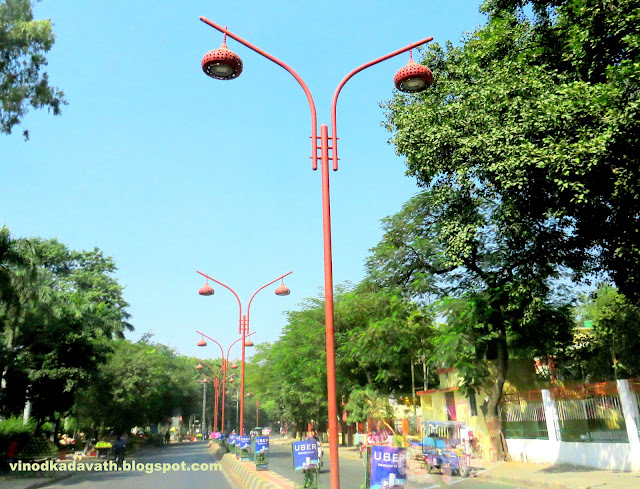I had read much about Lucknow over the years. It was the capital of the Nawabs of Awadh during the 18th and 19th century who lived well, enjoyed the arts and indulged in good food. Hence, Lucknow is often lovingly referred to as the city of Nawaabs, Tehzeeb (Respect), Kebab (Food) & Shabaab (Beauty). The rulers of many dynasties ruled the city which finally came under the rule of British. After independence, the city was made the capital of Uttar Pradesh.
A road trip from Kanpur to Lucknow on a Sunday morning and much of the countryside appeared just as I had imagined. During the 2 hours journey covering 94 kms, I noticed the empty paddy fields on both the sides covered by smog.
Here are some places you must visit while in Lucknow.
MARVEL AT THE ARCHITECTURE OF BARA IMMAMBARA
Nestled in expansive lawns, Bara Imambara, also known as Asafi Imambara was constructed in 1784 by Nawab Asaf-ud Daulah, the fourth Nawab of Awadh. Bara means huge or big, and an imambara (a congregation hall) is a shrine for Muslim community built by Shia Muslims for the purpose of prayer or Azadari. The monument has two levels of entrances, a large courtyard, and gardens. You can take the entry ticket from the second entrance.
The main building is constructed on a high platform and this three storey building is still impressive. The main feature of this monument is that no pillars or beams were used to support the roof and it shows the architecture sensibility of the era.
The central hall which is the largest among nine halls in the monument, has the tomb of Asaf-ud-Daula and a beautifully designed ceiling.
 |
| Central Hall. Bara Imambara, Lucknow |
The eight other halls are small and surround the central one, divided by thick pillars and walls.
LABYRINTH ( BHUL BHULAIYYA)
Bhul Bhulayya is a part of the monument that has a network of walls. It is a labyrinth of hundreds of narrow stairway passages, some of which also have dead ends, which was constructed to confuse intruders. It is easy to get lost when you walk through these passages.
 |
| Labyrinth (Bhul Bhulayya), Bara Imambara, Lucknow |
ASFI MOSQUE
Asafi Masjid was constructed by Nawab Asaf-ud-Daulah. No iron was used in the construction of the mosque which makes it stand out. The mosque is located to the right of the Bara Imambara’s gate.
 |
| Asafi Mosque, view from Bara Imambara, Lucknow |
SHAHI BAULI ( BARA) IMAMBARA
Shahi bauli is situated inside the Bara Imambara and this monument has a five-storey baoli or step well and is also known as Shahi Hammam. It is said that the step well is directly connected to Gomti.
 |
| Shahi Bauli, Bara Imambara, Lucknow |
CHOTA IMMAMBARA
Chota Imambara is also known as Imambara Hussainabad Mubarak. Mohammad Ali Shah, the third Nawab of Awadh, built the imambara. Here Shia Muslims perform mourning ceremonies in the month of Muharram. This imambara is also a mausoleum of the third nawab and his mother. The grand gateway of Chota Imambara is referred to as the Naubat Khana. There are five doors to enter the imambara along with two halls and a platform. Looking at the central line of fountains and hanging bridge of the Char Bagh styled gardens, similar to the Taj Mahal, you inhabit again the world of the Nawab's. This must be how they lived.
The entire hallway is filled with colorful chandeliers that supposedly came from Belgium. Gilded mirrors, stunning lamps and more antiquities are from Europe.
RUMI DARWAZA ( RUMI GATE )
A short walk from Bara Imambara is the Rumi Darwaza, which was built by Nawab Asaf-ud-Daulah in 1784 on the basis of Awadhi architecture. Rumi Darwaza is also known as Turkish Gate as per the resources from the British. Historians say that the structure is the replica of a gate in Constantinople currently known as Istanbul.
HUSSAINABAD CLOCK TOWER
Husainabad Clock Tower is located adjacent to the Rumi Darwaza, and is a perfect example to the artistic and structural skills of the Englishmen. It was built in the year 1881 by Nawab Nasir-ud-din Haider to mark the arrival of Sir George Couper, 1st Lieutenant Governor of United Province of Avadh. Husainabad clock tower is considered as the tallest among all the clock towers in India and was built as a replica to the BIGBEN clock tower of London.
SHOPPING AND FOOD
Like most culinary cities, Lucknow has plenty of great markets for shopping and eating. Some of the major and famous shopping places in Lucknow are Aminabad, Kapoorthala, Hazratganj and Janpath. As we turned onto bustling Aminabad market, we were trying hard to walk through the crowd.
 |
| Aminabad Market, Lucknow |
The first thing that comes to mind while talking about shopping in Lucknow is of course the famous "Chikankari" (means Chikan embroidery work ) of Lucknow, , which is well-known all over India. Chikan is a very famous thread work that is done by the skilled craftsmen of Lucknow. It is combined with crystal work and embroidered on clothes for women, men and kids.
 |
| "Chikankari" of Lucknow |
What is on the menu in Lucknow? Tunday Kebab and Kachori, accompanied by Makhan Malai, a kind of frothy sweet dish. The Mughal and Awadhi cuisines, which dominate most of the North Indian food worldwide, originated in Lucknow. Tunday means handicapped and they got their name because the person who made them first was handicapped. Over a 100 masalas go into the making of this royal kebab and are best served with rumali roti. A visit to Lucknow is incomplete without trying the local favourite - Tunday Kebab.


































































